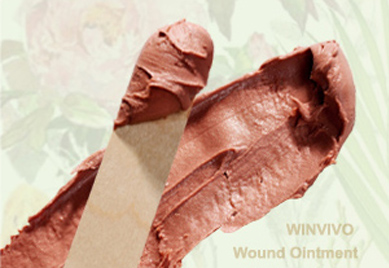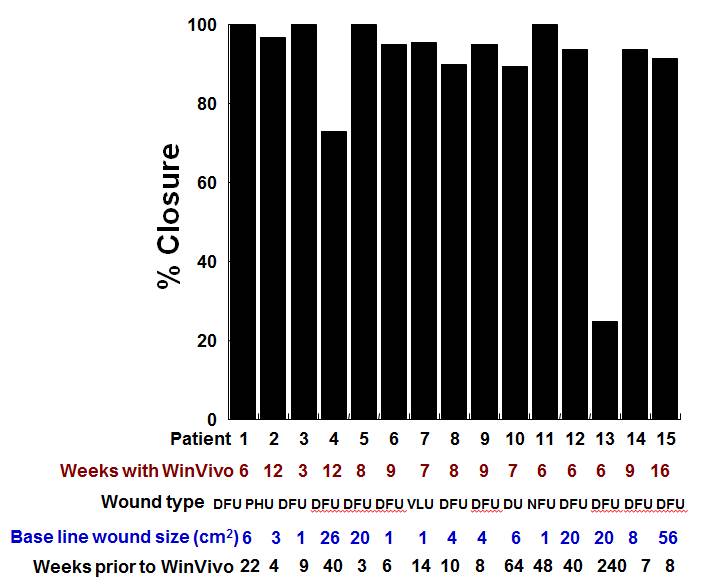Diabetic Foot Ulcers
 The World Health Organization (WHO) estimates that more than 180 million people worldwide have diabetes; and the estimates are likely to more than double by 2030. In the United States, in 2011 about 26 million people had diabetes, and among the adults aged 20 years or older 79 million are prediabetic. In emerging economies, the population of diabetics has also grown rapidly with the Middle East region ranking the highest.
The World Health Organization (WHO) estimates that more than 180 million people worldwide have diabetes; and the estimates are likely to more than double by 2030. In the United States, in 2011 about 26 million people had diabetes, and among the adults aged 20 years or older 79 million are prediabetic. In emerging economies, the population of diabetics has also grown rapidly with the Middle East region ranking the highest.
It is estimated that up to 25% of all diabetics will develop a diabetic foot ulcer and about 12-24% of these patients eventually will undergo lower extremity amputations as a result of infection or gangrene secondary to unhealed foot ulcers. Unfortunately, the 5-year survival rate after one major lower extremity amputation is only about 50%. Once amputation occurs, 50% of patients will develop an ulcer in the other limb within 5 years.
A diabetic foot ulcer is an open sore or wound that most commonly occurs on the bottom of the foot. Ulcers form due to a combination of factors, such as lack of feeling in the foot, poor blood circulation, foot deformities, irritation (such as friction or pressure), and trauma, as well as duration of diabetes as the underlying disease. Patients who have diabetes for many years can develop neuropathy, a reduced or complete lack of feeling in the feet due to nerve damage caused by elevated blood glucose levels over time. Vascular disease can complicate a foot ulcer, reducing the body’s ability to heal and increasing the risk of infection. Elevation in blood glucose levels can reduce the body’s ability to fight off a potential infection and also retard healing.
The primary goal in the treatment of foot ulcers is to obtain healing as soon as possible. The faster the healing, the less chance the ulcer will get infected.
Here are the key factors in the appropriate treatment of a diabetic foot ulcer:
- Prevention of infection
- Taking the pressure off the area (off-loading)
- Removing dead skin and tissue (debridement)
- Applying medication or dressings to the ulcer
- Managing blood glucose and other health problems
Over the past 2 decades significant progress has been made in the development of a wide variety of advanced wound care modalities in managing acute and chronic wounds. However, complete healing of diabetic foot ulcers remains a challenge due to many factors such as:
- Prolonged inflammation that stalls wound healing
- Excessive wound drainage and formation of bacterial biofilms that are resistant to antibiotic treatment
- Poor blood circulation (ischemia)
- Poorly controlled blood glucose level (hyperglycemia)
- Weakened barrier function (due to aging or use of steroids) rendering the skin susceptible to tears and the subsequent development of infection
- Constant weight bearing over abnormal bony prominences and/or pressure points
To address these complex issues of wound healing, one may take a "cocktail" approach and consider using a multi-functional botanical therapy that combines:
- Botanicals with broad-spectrum anti-microbial properties to protect wound bed from infection and to inhibit growth of microorganisms without harming delicate regenerating tissue;
- Naturally anti-inflammatory and analgesic botanicals to suppress prolonged inflammation and pain;
- Botanicals that promote microcirculation of the low extremities to allow fast drainage and tissue regeneration;
- Formulation that is able to absorb wound fluid (exudate) and also maintain a physiologically moist wound healing environment without causing maceration
- Formulation that allows painless and less frequent dressing change; and
- Formulation that can heal wound fast and effectively with maximum restoration of skin function and minimal scarring.
Related Product
WINVIVO Wound Ointment
 This is a uniquely-effective, multi-functional botanical ointment clinically proven to accelerate healing of chanllenging wounds and skin ulcers. Its unique paste formulation includes naturally antimicrobial, anti-inflammatory and analgesic botanicals to inhibit infection, suppress itching and pain promote microcirculation and tissue generation.
This is a uniquely-effective, multi-functional botanical ointment clinically proven to accelerate healing of chanllenging wounds and skin ulcers. Its unique paste formulation includes naturally antimicrobial, anti-inflammatory and analgesic botanicals to inhibit infection, suppress itching and pain promote microcirculation and tissue generation.
Botanicals in WINVIVO Wound Ointment
Borneol resin (Dryobalanops aromatica)
Borneol resin has been shown to be antibiotic having an inhibitory effect against Staphylococcus aureus, Diplococcus pneumonia, E. coli, Pseudomonas aeruginosa, and other dermatophytes. It has been used to treat dizziness, otitis, and various forms of abscesses and swellings.
 Camellia Oil or Tea Seed Oil (Camellia oleifera)
Camellia Oil or Tea Seed Oil (Camellia oleifera)
Composed mainly of Oleic acid (almost 82%, the highest among all natural oils), camellia oil is the most penetrative of all natural oils, capable of permeating deeply into the lower layers of the skin to greatly enhance the beneficial effects of our natural collagen and elastin.
Coptis root (Coptis chinensis Franch.)
 The dried rhizome of Coptis chinensis Franch is used in the preparation of the Healing Balm. Traditional Uses of Coptis Root The first record for medical use of coptis has been appeared in the Chinese medical literature of The Divine Farmer’s Materia Medica (25 A.D. to 220 A.D).
The dried rhizome of Coptis chinensis Franch is used in the preparation of the Healing Balm. Traditional Uses of Coptis Root The first record for medical use of coptis has been appeared in the Chinese medical literature of The Divine Farmer’s Materia Medica (25 A.D. to 220 A.D).
Corydalis tuber (Corydalis turtschaninovii)
 Corydalis tubers have been shown to be analgesic, sedative and tranquilizing but has not been shown to cause dependence, and to be anti-inflammatory in inhibiting histamine release and formation of edema in animals in both acute and chronic phases of inflammation.
Corydalis tubers have been shown to be analgesic, sedative and tranquilizing but has not been shown to cause dependence, and to be anti-inflammatory in inhibiting histamine release and formation of edema in animals in both acute and chronic phases of inflammation.
Dragon's Blood resin (Daemonorops draco)
 Traditionally, Dragon's Blood resin has been used externally to stop bleeding, promote generation of flesh, and contain ulceration in the treatment of traumatic injuries, non-healing ulcers and hemorrhoids with swelling and pain.
Traditionally, Dragon's Blood resin has been used externally to stop bleeding, promote generation of flesh, and contain ulceration in the treatment of traumatic injuries, non-healing ulcers and hemorrhoids with swelling and pain.
Fritillaria (Fritillaria cirrhosa)
 For thousands of years fritillaria has been used in Asia to clear heat and to moisten the lung dryness, for heat-type bronchitis with dry cough and for the heart (to calm heart fire). Fritillaria is also used for treating lumps beneath the skin, such as scrofulous swellings and breast lumps.
For thousands of years fritillaria has been used in Asia to clear heat and to moisten the lung dryness, for heat-type bronchitis with dry cough and for the heart (to calm heart fire). Fritillaria is also used for treating lumps beneath the skin, such as scrofulous swellings and breast lumps.
Lithospermum root (Lithospermum erythrorhizon)
 In modern reserach, lithospermum root has marked anti-inflammatory effects and promotes healing. It has been used clinically to treat psoriasis, burns, cervical erosion, and hepatitis.
In modern reserach, lithospermum root has marked anti-inflammatory effects and promotes healing. It has been used clinically to treat psoriasis, burns, cervical erosion, and hepatitis.
Rhubarb root (Rheum palmatum)
 In traditional Chinese Medicine, rhubarb is used extensively as a purgative to treat a wide variety of accumulations, including constipation caused by excess heat, epigastric distention, fullness.
In traditional Chinese Medicine, rhubarb is used extensively as a purgative to treat a wide variety of accumulations, including constipation caused by excess heat, epigastric distention, fullness.
Tree peony bark (Paeonia suffruticosa Andr.)
 This botanical is used for clearing heat and cools blood, invigorating blood circulation and dispersing blood stasis in traditional Chinese Medicine.
This botanical is used for clearing heat and cools blood, invigorating blood circulation and dispersing blood stasis in traditional Chinese Medicine.
Note:
Please be advised that the information presented above is not to be used as a substitute for medical advice, diagnosis or treatment of any disease. Statements made about products have not been evaluated by the Food and Drug Administration. Viewers should not rely solely on the information provided on this web site for their own health problems, and are advised to consult with their physicians or other healthcare providers.
User Experience
- Girlfriend Set Me Straight
~ Pamela W.
- I am very into natural remedies
~ Alex H.
- Headache Gone Overnight
~ Josh L.
- Blocked sickness on the way
~ Jeff C.
Related FAQs
WINVIVO Wound Ointment:
Multi-Functional Botanical Therapy
- Difficult-to-Heal Wounds
Clinical Case Reports
- Diabetic Foot Ulcers
- Venous Leg Ulcers
- Skin Ulcers of Mixed Etiology
- Pressure Ulcers/Bedsores
- Surgical Wounds
- Traumatic Wounds


Privacy Policy | Disclaimer | Knowledge Garden Disclaimer | Return Policy | Contact Us | Affiliate Program
© 2009-2013 WinVivo Corporation All Rights Reserved






